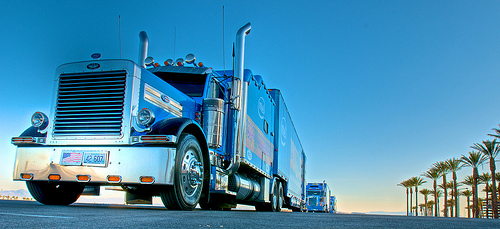Custom Big Rigs: Aftermarket Exhaust in the Commercial Driving World
In the commercial driving industry, fuel-economy and exhaust issues are increasingly consequential, especially as gas prices remain high and emission restrictions tighten. The benefits of upgrading a big rig’s exhaust system, therefore, become increasingly attractive. Though the inspiration for integrating better-performing exhaust parts into big rigs is often more oriented toward reducing the environmental impact of fuel consumption and emissions than the average consumer who is interested in beefing up their ride, the focus on these issues means that the commercial driving industry is in a position to lead the way in improving exhaust technology.

Intel custom shipping trucks used for trade shows and conventions
Large Diameter Free-Flowing Exhaust and Intake
A larger diameter means air flows more freely so there is less energy wasted by the engine on pushing air through the system. Big rig exhausts take advantage of this and also typically employ smooth bends created by mandrel bending machines, which ensure a consistent diameter throughout the exhaust. For diesel engines, this creates an increase in both fuel efficiency and performance.
Exhaust Manifold Upgrades
This upgrade offers an increase in performance and fuel economy. Original equipment manufacturer (OEM) manifolds have been known to have problems with cracks and leaks, so an upgrade might also save you the downtime and cost of repair. Though the boost may be slight (somewhere around 30 horsepower and 0.3 mpg), big rigs see enough use that this can easily be worth it in the long run.
Exhaust Brakes
Truckers are familiar with “Jake Breaks” as they have often been used for supplemental breaking in a downgrade. Supplemental breaking is important for vehicles that take a lot of wear and tear on their service breaks. In addition to increased safety, the ability to spread the strain across supplemental breaks can also mean less repairs and downtime spent on the main breaks.
Unfortunately, Jake breaks tend to be a noise pollutant that causes them to be restricted in many areas. Alternatively, exhaust breaks are nearly silent and slow a vehicle by cutting off the exhaust path from the engine, creating back-pressure and effectively causing the engine to run backward. A combination can also be employed to cut back on the noise.
Catalyst Muffler/Diesel Oxidation Catalyst (DOC)
Though this type of exhaust technology will not improve performance, it will reduce harmful emissions. In the commercial driving industry, this type of technology is necessary to meet regulations and so it must be balanced into the equation of increasing performance and economy. For the rest of the world, it is a viable option for the environmentally concerned, but those focused more on high-performance may be inclined to avoid these as they will be restrictive to air flow.
For a trucker, how the truck looks and performs is a point of pride. In the industry, how the truck performs in terms of efficiency and clean emissions is also a matter of staying ahead in a growing and changing field. Given the benefits of upgrading exhaust systems, whether improved performance, style, or efficiency, there aren’t many good reasons to avoid it for those who are looking to gain ground in the commercial driving world. The only real restriction to bear in mind is compliance with state legislation and regulatory agencies in terms of noise and emissions.
Guest author Hank Barton is a second generation trucker-philosopher with a penchant for the written word. He enjoys blogging about long haul trucking, safe driving practices and life on the open road. He writes for E-Gears, an online CDL Test authority that specializes in a variety of study guides.








